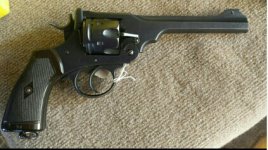I've seen a photograph somewhere of another gun converted like that, only it didn't have the additional cylinder part to mask the gap. BillM is correct in stating that the idea was to eliminate the cylinder jump, presumably (and questionably) to increase accuracy.
There were nice full-size .22 revolvers available in the 1930s as well as the .22 caliber Colt Government Model, which has a name I don't remember. But given the economic conditions during that period, I doubt the sold in great numbers.
Also, because of the differing economics of the period which are difficult to understand today, as well as for other reasons, I think there were more oddball conversions and modifications like that before WWII. Already there were conversions of surplus military rifles being done, even including some that we would be surprised that anyone would bother attempting now. The economies of doing things began changing after WWII but converting military bolt actions became more popular than ever, down through the 1960s.

